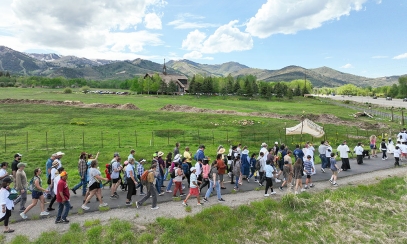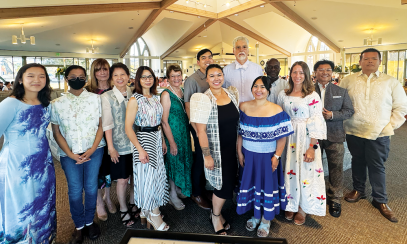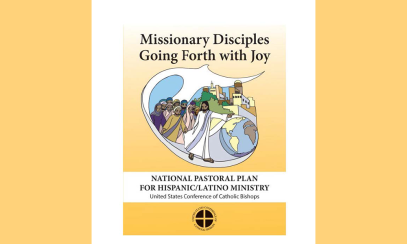The Final Report from the Synod on Synodality
In the late afternoon of Saturday, Oct. 28, the members of the XVI Ordinary General Assembly of the Synod of Bishops adopted the synthesis report titled A Synodal Church in Mission, after meeting for more than three weeks. The new synod format had 365 delegates (344 voting members), including bishops, laypeople and consecrated. The delegates sat at roundtables discussing synod priorities in small group settings, and the 41-page report was the end result after a two-thirds majority voted for final approval of the text. The report will be taken into account for the next stage of the synod – another Vatican assembly in Oct. 2024 – and the goal is that it will further position the Church to go forth and preach the Gospel, united as one Body of Christ.
In the late afternoon of Saturday, Oct. 28, the members of the XVI Ordinary General Assembly of the Synod of Bishops adopted the synthesis report titled A Synodal Church in Mission, after meeting for more than three weeks. The new synod format had 365 delegates (344 voting members), including bishops, laypeople and consecrated. The delegates sat at roundtables discussing synod priorities in small group settings, and the 41-page report was the end result after a two-thirds majority voted for final approval of the text. The report will be taken into account for the next stage of the synod – another Vatican assembly in Oct. 2024 – and the goal is that it will further position the Church to go forth and preach the Gospel, united as one Body of Christ.
Part 1: The Face of the Synodal Church
The first part of the synthesis report establishes the theological foundation, understanding and practice of synodality that roots itself in the Trinity and unfolds through variety and unity in the Church.
- There is a need to make the faith more accessible to all peoples in light of their baptism.
- Proposals to better unite and incorporate Eastern Catholic Churches with the Latin Church.
Part 2: All Disciples, All Missionaries
Part two addresses all who make up the Body of Christ and their relationships with each other.
- Connecting charisms to ministries and filling holes in the Church’s needs requires creativity and involvement of the young.
- Contributions of women need to be more valued and recognized, and the Church needs to explore what roles women can assume in the Church.
- The relationship between the bishop and the local Church needs deepening.
Part 3: Weaving Bonds, Building Community
The final part of the report presents synodality as a process of exchanges between the Churches and dialogue with the world.
- The people of God need better formation on what the Church teaches concerning relationships, sexual education and identity, and the human experience through a theological lens.
- The Church needs to adapt to listen more and accompany the people of God better to include those who have felt excluded from the life of the Church.
- Expanding digital outreach is necessary while educating people on appropriate digital discipleship to minimize the harm that can be caused in a digital space.
Post-synod discussion
The report included notable proposals to establish new ministries for the laity, increase lay involvement in decision-making, create processes to evaluate bishops’ performance of their ministry, change the way the Church discerns “controversial” issues, and expand the footprint of synodal assemblies going forward.
Although the report was structured so that sections highlight convergences, matters for consideration and proposals, “it’s evident that the points lacking consensus stand out,” says Catholic News Agency’s Andrea Gagliarducci in an article on the key discussions and decisions of the synod.
According to another CNA article by Jonathan Liedl, two sections that received some of the most opposition concerned proposals related to the possible inclusion of women in the diaconate:
Sixty-seven members voted against the proposal that “theological and pastoral research on women’s access to the diaconate should be continued,” taking into account the results of two commissions Pope Francis established to study the topic. “If possible, the results should be presented at the next session of the assembly,” the report proposed.
Sixty-one members opposed a proposal that said a “deeper reflection” on the diaconate’s status as “a proper and permanent degree of the hierarchy” would “also illuminate the issue of women’s access to the diaconate.”
Some of the synod’s most significant concrete proposals came in the form of calls for changes in ecclesial decision-making and the expansion of synodal assemblies and bodies in the life of the Church. “Some issues, such as those related to gender identity and sexual orientation, the end of life, difficult marital situations, and ethical issues related to artificial intelligence, are controversial not only in society but in the Church because they raise new questions,” the document stated.
No longer a bishops-only affair
Now that religious and laypeople have joined the table, some bishops have indicated there is no going back to the old way of addressing Church issues. “It would seem to me impossible to go back now. It would be wrenching to go back if you just had bishops there or just bishops voting,” Cardinal Robert McElroy from the Diocese of San Diego said.
Going forward
At the closing Mass, Pope Francis said: “We may have plenty of good ideas on how to reform the Church, but let us remember: to adore God and to love our brothers and sisters with his love, that is the great and perennial reform.”
We are always at risk of thinking that we can ‘control God,’ that we can confine his love to our own agenda. Instead, the way he acts is always unpredictable, it goes beyond, and, consequently, this action of God demands amazement and adoration,” he added.
Sections of synthesis report
Part 1: The Face of the Synodal Church
1. Synodality: Experience and Understanding
2. Gathered and Sent by the Trinity
3. Entering the Community of Faith: Christian Initiation
4. People in Poverty, Protagonists of the Church’s Journey
5. A Church “out of every tribe, tongue, people and nation”
6. The Eastern Churches and Latin Church Traditions
7. On the Road Towards Christian Unity
Part 2: All Disciples, All Missionaries
8. Church is Mission
9. Women in the Life and Mission of the Church
10. Consecrated Life and Lay Associations and Movements: a Charismatic Sign
11. Deacons and Priests in a Synodal Church
12. The Bishop in Ecclesial Communion
13. The Bishop of Rome in the College of Bishops
Part 3: Weaving Bonds, Building Communities
14. A Synodal Approach to Formation
15. Ecclesial Discernment and Open Questions
16. Towards a Listening and Accompanying Church
17. Mission in the Digital Environment
18. Structures for Participation
19. Groupings of Churches within the Communion of the Whole Church
20. The Synod of Bishops and Ecclesial Assemblies



